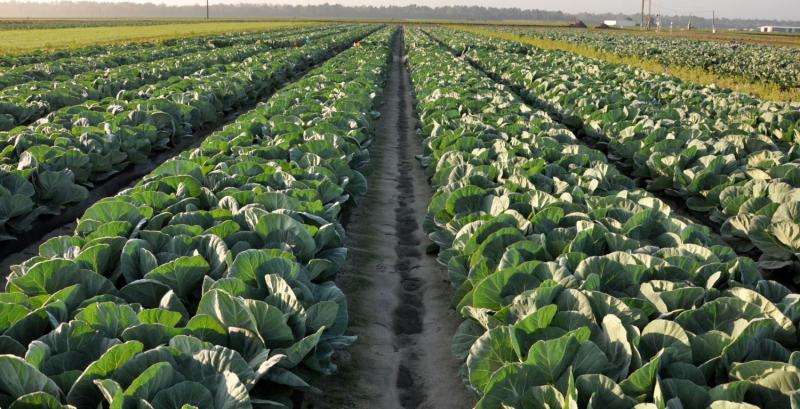Plasticulture system offers alternative for cabbage producers

In Florida, a major fresh-market cabbage producing state, cabbage production currently relies on bare ground and subirrigation systems. Because of the large volume of water these systems need for irrigation, finding alternative production methods is a pressing need. Researchers at the University of Florida recently determined that plasticulture systems using drip irrigation can be effective for cabbage production in the state.
According to the study in the October 2015 issue of HortScience, current commercial production practices for cabbage under seepage irrigation rely on bare ground hills spaced 1 m apart with an in-row plant spacing of 20 cm, which typically results in about 48,438 plants/ha. "Evaluations conducted in commercial cabbage fields in northeast Florida showed that 30% of the planted population was not harvested because the cabbage heads failed to reach marketable size or were of poor quality," the authors said. They noted that plasticulture has been extensively used in commercial production of other horticultural crops, but has not been widely adopted for commercial fresh-market cabbage production in the United States because of a lack of information on management strategies and economic feasibility.
The scientists performed field experiments with the commercial cabbage cultivar Bravo grown during three growing seasons (two winter seasons and one fall season) in Hastings, Florida. "Having had two different years, in terms of growing conditions, presented a unique opportunity to evaluate in-row plant spacing and row configuration for superior performance regardless of climate variability," the authors noted. The cabbage was grown on 1.2-m-wide raised beds with black plastic mulch and drip irrigation in either three or four rows with in-row plant spacings ranging from 15 to 35 cm and plant populations ranging from 41,518 to 129,167 plants/ha.
Results showed no significant differences related to growing seasons in total number of cabbage heads harvested.
There were significant differences in the total number of heads harvested between the in-row spacing and row configuration treatments. Wider in-row spacings produced a greater percentage of heads of marketable size while reducing the percentage of small heads when compared with narrower in-row spacings. Mean cabbage head weight increased as in-row spacing increased. A three- or four-row configuration with in-row spacing between 25 and 30 cm had consistently high yields in all three seasons when compared with narrower in-row plant spacings.
"The results from these trials indicate that, with a high population plasticulture system, variable plant populations could be selected depending on planting date and expected weather conditions during the growing season," said the authors. "In-row plant spacings between 30 and 35 cm may be beneficial for early planting dates, while 25-cm spacing could be more productive for later plantings, especially when weather conditions are favorable."
More information: The complete study and abstract are available on the ASHS HortScience electronic journal web site: hortsci.ashspublications.org/c … /50/10/1472.abstract
Journal information: HortScience
Provided by American Society for Horticultural Science



















